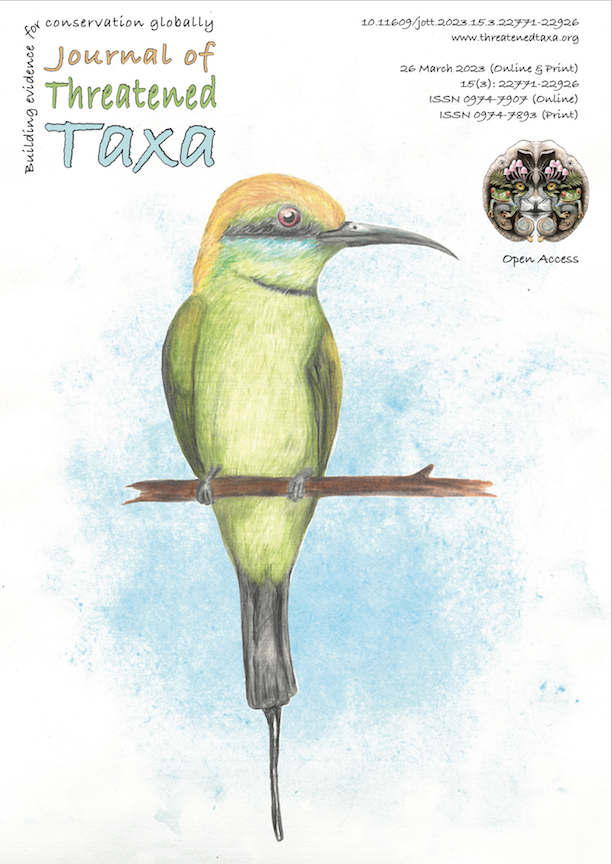A new termite species of the genus Bulbitermes (Blattodea: Isoptera: Termitidae) from Meghalaya, India
Main Article Content
Abstract
A new termite species, Bulbitermes debadiliporum sp. nov., of the nasutiform genus Bulbitermes is described here from the Mawlynnong area of the East Khasi Hills district and Nongkhrah Village of the Ri-Bhoi district of Meghalaya, India. The species is described based on the soldier & worker castes, and a detailed illustration of the diagnostic characteristics of both the castes is provided here. Soldiers of the species are monomorphic whereas the workers are dimorphic with worker major and worker minor. Worker dimorphism is reported hitherto for the first time among Bulbitermes species of the Indian region. Furthermore, an updated identification key of Bulbitermes species from the Indian region is also provided here.
Article Details

This work is licensed under a Creative Commons Attribution 4.0 International License.
Authors own the copyright to the articles published in JoTT. This is indicated explicitly in each publication. The authors grant permission to the publisher Wildlife Information Liaison Development (WILD) Society to publish the article in the Journal of Threatened Taxa. The authors recognize WILD as the original publisher, and to sell hard copies of the Journal and article to any buyer. JoTT is registered under the Creative Commons Attribution 4.0 International License (CC BY), which allows authors to retain copyright ownership. Under this license the authors allow anyone to download, cite, use the data, modify, reprint, copy and distribute provided the authors and source of publication are credited through appropriate citations (e.g., Son et al. (2016). Bats (Mammalia: Chiroptera) of the southeastern Truong Son Mountains, Quang Ngai Province, Vietnam. Journal of Threatened Taxa 8(7): 8953–8969. https://doi.org/10.11609/jott.2785.8.7.8953-8969). Users of the data do not require specific permission from the authors or the publisher.
Funding data
-
University Grants Commission
Grant numbers Award no. F1-17.1/2017-18/RGNF-2017-18-SC-ASS-35335
References
Ahmad, M. (1965). Termites (Isoptera) of Thailand. Bulletin of the American Museum of Natural History 131: 1–113.
Akhtar, M.S. (1975). Taxonomy and zoogeography of the termites (Isoptera) of Bangladesh. Bulletin of the Department of Zoology, University of the Punjab 7: 1–199.
Arumugam, N., N.S.M. Kori & H. Rahman (2018). Termites identification, pp. 27–46. In: Khan, M. A. & W. Ahmad (eds.). Termites and Sustainable Management, Volume 1. Springer Nature, Switzerland, 265 pp. https://doi.org/10.1007/978-3-319-68726-1
Brullé, G.A. (1832). Expedition scientifique de Moree. Section des sciences physiques zoologie. Deuxieme section— des animaux articules, Vol. 3, part 1. F.G. Levrault, Paris, 400 pp.
Chhotani, O.B. (1997). The Fauna of India and the Adjacent Countries. Isoptera (Termites): (Family Termitidae), Vol. 2. Zoological Survey of India, Calcutta, xx+800 pp.
Chuah, C.H. (2005). Inter specific variation in defence secretions of Malaysian termites from the genus Bulbitermes. Journal of Chemical Ecology 31: 819–827. https://doi.org/10.1007/s10886-005-3546-8
Emerson, A.E. (1949). Descriptions of new genera, pp. 374–377. In: Snyder, T.E. (ed.). Catalog of the termites of the world. Smithsonian Miscellaneous Collections 112(3953): 1–490.
Eggleton, P. (2000). Global pattern of termite diversity, pp. 25–51. In: Abe, T., D. E. Bignell & M. Higashi (eds.). Termites: Evolution, Sociality, Symbiosis, Ecology. Springer, Dordrecht, xxii+435 pp.
Hare, L. (1937). Termite phylogeny as evidenced by soldier mandible development. Annals of the Entomological Society of America 37(3): 459–486.
Inward, D., G. Beccaloni & P. Eggleton (2007). Death of an order: A comprehensive molecular phylogenetic study confirms that termites are eusocial cockroaches. Biology Letters 3: 331–335.
Krishna, K. (1965). Termites (Isoptera) of Burma. American Museum Novitates 2210: 1–34.
Krishna, K., D.A. Grimaldi, V. Krishna & M.S. Engel (2013a). Treatise on the Isoptera of the world: Introduction, Vol. 1. Bulletin of the American museum of Natural History 1: 1–202.
Krishna, K., D.A. Grimaldi, V. Krishna & M.S. Engel (2013b). Treatise on the Isoptera of the world: Termitidae, Vol. 5. Part 2. Bulletin of the American museum of Natural History 5: 1499–1901.
Latreille, P.A. (1802). Histoire naturalle, generale et particuliere des crustaces et des insects. Vol. 3. F dufart, Paris, 467 pp.
Lommen, S., V.H. Arnold & S.S. Ahmad (2004). Caste biology and behavior of Bulbitermes sarawakensis (Isoptera, Nasutitermitinae) in Malaysia. Proceedings of Netherlands Entomological Society 15: 21–27.
Maiti, P.K. & N. Saha (2000). Description of two new species of termites (Isoptera: Insecta) from Assam, India. Records of the Zoological Survey of India 98(4): 89–97.
Roonwal, M.L. & O.B. Chhotani (1989). The Fauna and the Adjacent Countries. Isoptera (Termites): Vol. 1. Zoological Survey of India, Calcutta, 672 pp.
Syaukani & G.J. Thomson (2011). Taxonomic Notes on Nasutitermes and Bulbitermes (Termitidae, Nasutitermes) from the Sunda region of Southeast Asia based on morphological and molecular characters. Zookeys 148: 135–160.
Weesner, F.M. (1965). The Termites of the United States: A Handbook. Elizabeth. National Pest Control Association, 67 pp.

